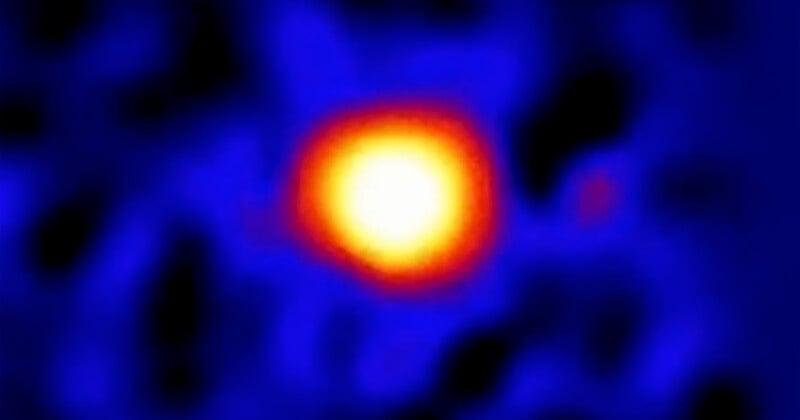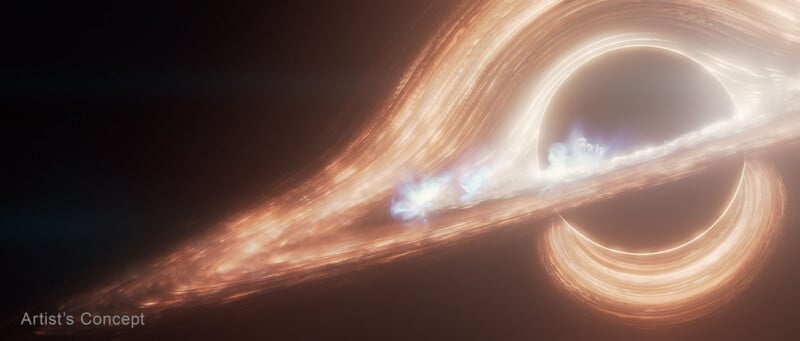Webb Captures Cosmic Fireworks in Unprecedented Timelapse of a Supermassive Black Hole

Astrophysicists using the James Webb Space Telescope (JWST) captured the longest and most detailed look ever of Sagittarius A*, the supermassive black hole at the center of the Milky Way galaxy.
Of course, looking directly into a black hole like Sagittarius A* is impossible since its gravitational forces are so strong that not even light can escape it. However, as has been demonstrated through projects like the Event Horizon Telescope, it is possible to detect and observe black holes through their effects on surrounding matter and interstellar material.
That’s precisely what JWST did. Using the powerful $10 billion space telescope’s near-infrared camera (NIRCam), which can observe two separate infrared wavelengths for extended periods, scientists observed the area surrounding Sagitarrius A* in eight to 10-hour increments across one year, totaling 48 hours of observations. This allowed researchers to observe how the black hole changed over time. Although one year doesn’t even constitute a blink in the cosmic timeline, the supermassive black hole proved surprisingly active.
‘This timelapse video compresses about 9 hours of infrared observations by NASA’s James Webb Space Telescope into 30 seconds. Webb observed the black hole at the center of the Milky Way, known as Sagittarius A* (A-star). Webb detected both faint flickers and brighter flares (one of which is seen near the end of the video). These brightness fluctuations may originate from two different processes,’ the Webb Space Telescope team explains.
The observations revealed “ongoing fireworks of various brightness and durations,” and the accretion disk (the swirling disk of gas and dust) surrounding the black hole produced an average of five to six “big flares” each day, with several relatively minor flares in between.
“In our data, we saw constantly changing, bubbling brightness,” says Farhad Yusef-Zadeh, professor of physics and astronomy at Northwestern University’s Weinberg College of Arts and Scientists and the lead author on an accompanying study, which was published this week in the The Astrophysical Journal Letters.

“And then boom! A big burst of brightness suddenly popped up. Then, it calmed down again. We couldn’t find a pattern in this activity. It appears to be random. The activity profile of the black hole was new and exciting every time that we looked at it.”
Sagittarius A* constantly emits flares of varying intensity. The new observations will help scientists better understand the nature of black holes, how they interact with surrounding matter, and possibly even how the Milky Way evolved how it did.
“Flares are expected to happen in essentially all supermassive black holes, but our black hole is unique,” Yusef-Zadeh explains. “It is always bubbling with activity and never seems to reach a steady state. We observed the black hole multiple times throughout 2023 and 2024, and we noticed changes in every observation. We saw something different each time, which is really remarkable. Nothing ever stayed the same.”
Precisely why Sagittarius A* behaves as it does is unknown, although astrophysicists like Dr. Yusef-Zadeh have theories. He suspects two separate processes drive the regular faint flares and the longer, brighter ones.
“If the accretion disk is a river, then the short, faint flickers are like small ripples that fluctuate randomly on the river’s surface. The longer, brighter flares, however, are more like tidal waves, caused by more significant events,” Northwestern University explains in a press release.
“It’s similar to how the sun’s magnetic field gathers together, compresses and then erupts a solar flare,” Yusef-Zadeh says. “Of course, the processes are more dramatic because the environment around a black hole is much more energetic and much more extreme. But the sun’s surface also bubbles with activity.”
Webb captured these groundbreaking timelapse images because its NIRCam instrument simultaneously observes two different wavelengths, 2.1 and 4.8 microns. With data across these wavelengths, researchers discovered that events at the shorter wavelength changed brightness slightly before longer-wavelength events, preceding them by a few to around 40 seconds.
The video below, edited by Space.com using data provided by the researchers, shows the timelapse data slightly differently.
This time delay is not only surprising but could also provide key insights into the physical processes occurring around the supermassive black hole.
Yusef-Zadeh and the rest of his team hope to use Webb to view Sagittarius A* for even longer periods, perhaps even 24 straight hours. Longer observations will offer many benefits, including reduced noise.
“When you are looking at such weak flaring events, you have to compete with noise,” Yusef-Zadeh remarks. “If we can observe for 24 hours, then we can reduce the noise to see features that we were unable to see before. That would be amazing. We also can see if these flares repeat themselves or if they are truly random.”
Image credits: NASA, ESA, CSA, Farhad Yusef-Zadeh (Northwestern), Howard Bushouse (STScI), Alyssa Pagan (STScI). The accompanying research was published this week, “Nonstop Variability of Sgr A* Using JWST at 2.1 and 4.8 μm Wavelengths: Evidence for Distinct Populations of Faint and Bright Variable Emission.” The paper’s authors are F. Yusef-Zadeh, H. Bushouse, R. G. Arendt, M. Wardle, J. M. Michail, and C. J. Chandler.